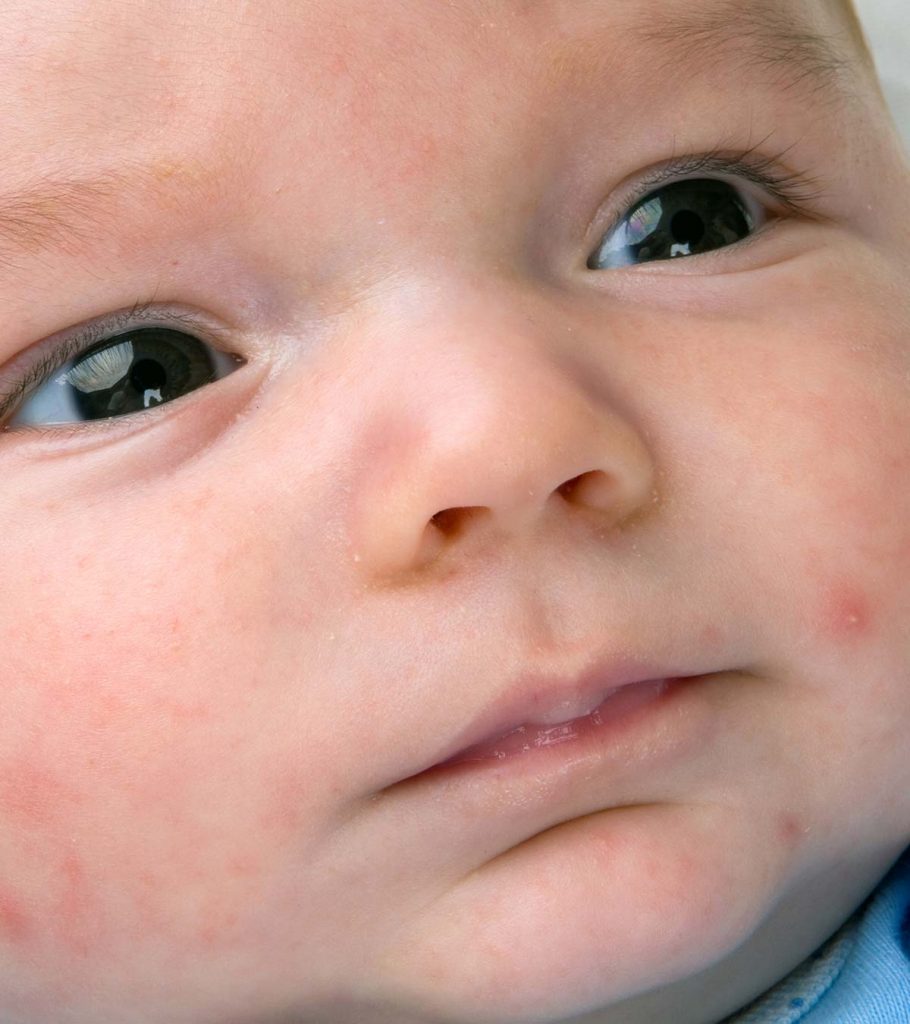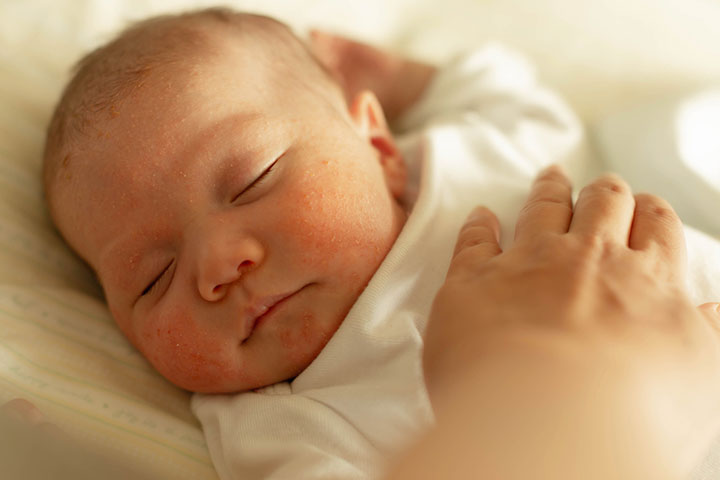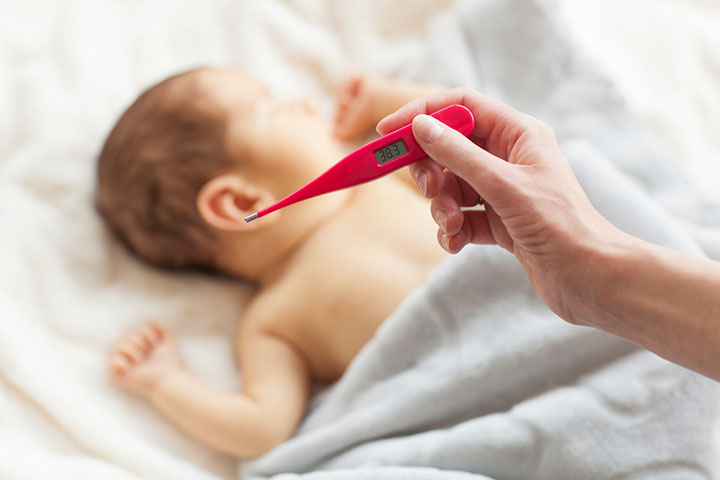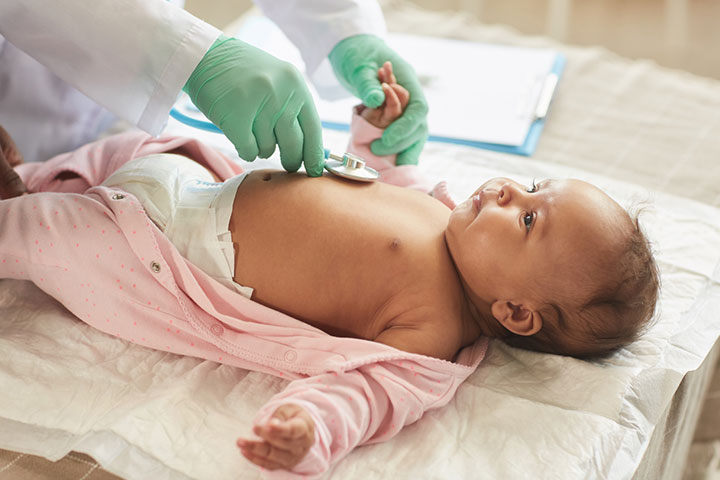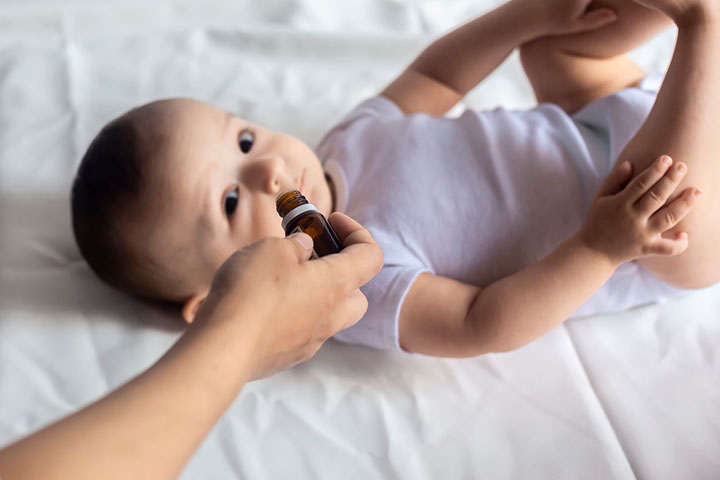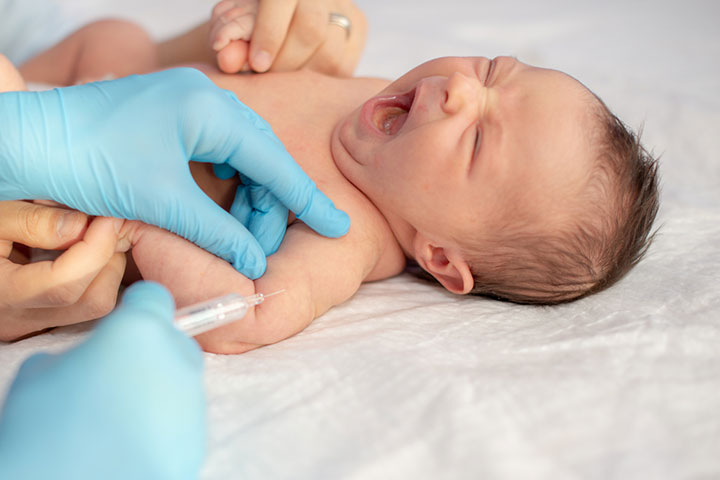Petechiae in babies can occur due to self-limiting conditions (such as birth trauma) and bleeding disorders that require prompt medical care. They are tiny, flat, red spots up to two millimeters in diameter. You may notice petechiae on the skin and mucous membrane of the baby (1). Petechiae is not a disease, so you may seek a doctor’s consultation to find the underlying causes.
Read on about the causes, associated symptoms, diagnosis, and treatment for petechiae in babies and ways to prevent them.
Causes Of Petechiae In Babies
Newborns may have petechiae on the skin due to birth trauma caused by vaginal delivery. It may be a little bit bigger than petechiae, even a bruise. This usually disappears within a week or two without medications.
Dr. Sharon Wiener, a board-certified pediatrician from Plano, Texas, says, “Physical trauma, such as a hard bout of coughing, breath-holding, vomiting, or crying, can cause facial petechiae. This occurs mostly around the eyes. With a more serious problem such as a bacterial or viral illness, the petechiae are generally on the torso, extremities, and buttocks and are related to other symptoms such as fever and extreme fatigue.”
Petechiae occur when the small blood vessels under the skin (capillaries) bleed into the skin. Capillary Hemorrhage in babies can occur due to many reasons, including (2):
- Coughing bouts
- Several instances of vomiting
- Tourniquet pressure such as from wearing a diaper or baby sling
- Bacterial infections such as meningococcemiaiXA serious infection resulting in fever, skin rash, and lesions, endocarditisiXInflammation of the inner lining of the heart caused by an infection, scarlet fever, etc
- Viral infections such as viral hemorrhagiciXA medical term for bleeding fevers, infectious mononucleosis, cytomegalovirus (CMV) infection, etc.
- Sepsis (Blood infections)
- Fungal infections
- LeukemiaiXA cancer of blood cells that affects the body’s immune system
- Hypersplenism (overactive spleen)
- Thrombocytopenia (low number of platelets)
- Platelet dysfunction and coagulationiXTransformation of blood from a liquid state to a solid or semi-solid state disorders
- Scurvy (vitamin C deficiency)
- Vitamin K deficiency
- Dysproteinemia (blood protein content disorder)
- Certain medications such as penicillin, Qualaquin (quinine), or Cerebyx (phenytoin)
- Sunburn
- Vasculitis
- Child abuse in the form of smothering, biting, strangulation or spanking
- Trauma
- Skin allergies, , such as atopic dermatitis
Amanda, a loving mom of two children from Texas, recalls talking to their pediatrician about her baby boy’s petechiae. She says, “She (the doctor) pulled up a chair and pulled out our chart and began explaining to us that our perfect little boy, wasn’t actually perfect. He was covered in red spots (well, yeah, we noticed them right away, but it’s just from coming through the birth canal, right?) No, those red spots are called petechiae and are caused by the lack of platelets in his blood (known as thrombocytopenia) (i).”
Symptoms Of Petechiae In Babies
The primary symptom of infantile petechiae is the appearance of pinprick sized red spots under the skin. These spots can also be purple or brown in color and often appear in clusters that look like skin rash. The spots are flat and don’t itch or blanch (turn pale) when you press them. Petechiae often appear on children’s faces, arms, stomach, chest, buttocks, and feet.
You may notice other signs and symptoms along with petechiae, depending on the underlying cause. Fever is the most common associated symptom seen in many infectious and noninfectious underlying causes.
When To See A Doctor
It is recommended to seek immediate medical care if your baby has petechial rashes since it can be a symptom of a severe medical condition or can be another type of rash. For instance, purpura rashes are also non-blanching on pressure tests, like petechiae, but are due to meningococcal septicemiaiXSpread of bacterial infection into the bloodstream that requires emergency care (1).
Seek immediate medical attention for the following, even though your baby is undergoing treatment for childhood petechiae.
- High fever (more than 100.4°F)
- Unexplained bruising
- Lethargy
- Abnormal pulse
- Increase in the size of the spots
Diagnosis Of Petechiae In Babies
Petechiae spots are usually recognizable due to their characteristic size and color. The doctor may also perform a glass test or pressure test using a glass to confirm the diagnosis. Petechial spots do not become colorless (pale) while applying pressure on it.
The doctor may order blood tests, urine tests, throat swab, imaging tests such as X-ray, or a lumbar puncture to confirm the cause of petechiae (1). Most of these tests are often ordered based on the results of initial blood tests and the presenting signs and symptoms.
Treatment For Petechiae In Babies
Treatment for petechiae may vary depending on the underlying cause. Petechiae due to bacterial infections will require antibiotic treatment, while petechiae due to coagulation disorders will require anticoagulants and other medications.
If there are no other concerning symptoms or causes, there is no requirement of treatment. Nevertheless, medical intervention for petechiae is necessary to determine the underlying cause (3). Any delay in diagnosing a severe causative illness may lead to fatal results.
After initial consultation for petechiae, follow any treatment plan the doctor suggests. Petechiae usually fade away without leaving any scars. Keep monitoring the spots for any changes in their numbers or color. If you notice any changes in petechiae spots, inform the doctor about it.
Prevention Of Petechiae In Babies
There is no vaccine available for petechiae in newborns. Since the cause of petechiae can be any medical condition, you may vaccinate your child for a specific disease. For instance, you can give your child the Hib vaccine for meningitisiXInflammation affecting the protective membrane of the brain and the spinal cord.
You can also take care of their diet to prevent petechiae from diseases like scurvy. Scurvy occurs due to vitamin C deficiency, so ask your doctor for diet suggestions before your baby is old enough (four to six months) to consume solid foods.
If your baby spends time in childcare (daycare) centers or you have hired help for childcare when you have to be away from home, make sure there are no chances of physical abuse in your absence that may be causing petechiae on the baby’s body.
Petechiae in babies is a typically harmless skin condition that can be recognized from its dot-sized distinctive red spots. Although it can arise from normal reasons such as cough, allergies, or birth trauma, petechiae may sometimes indicate an alarming condition such as meningococcal septicemia. Hence parents need to be aware of the signs and symptoms to seek appropriate treatment and avoid complications. In addition, you may consult your doctor about the preventive measures to protect your baby from the possible causes that can trigger the condition.
Key Pointers
- Petechiae, which are tiny, flat, red spots that can appear on neonates, are caused by birth trauma and bleeding issues, and require immediate medical attention.
- Petechiae develop when capillaries, which are tiny blood vessels beneath the skin, bleed into the skin.
- There are various reasons why babies may experience capillary bleeding, including coughing fits, vomiting, tourniquet pressure from diapers or baby carriers, bacterial or viral infections, sepsis (blood infections), platelet malfunction, coagulation issues, trauma, skin allergies, and others.
- Different treatments may be necessary for petechiae depending on the underlying cause. For example, petechiae caused by bacterial infections will require antibiotic treatment, whereas those caused by coagulation issues will require anticoagulants and other drugs.
Discover how to tell the difference between hives, petechiae, and purpura in babies. Know when to seek help from your pediatrician.
